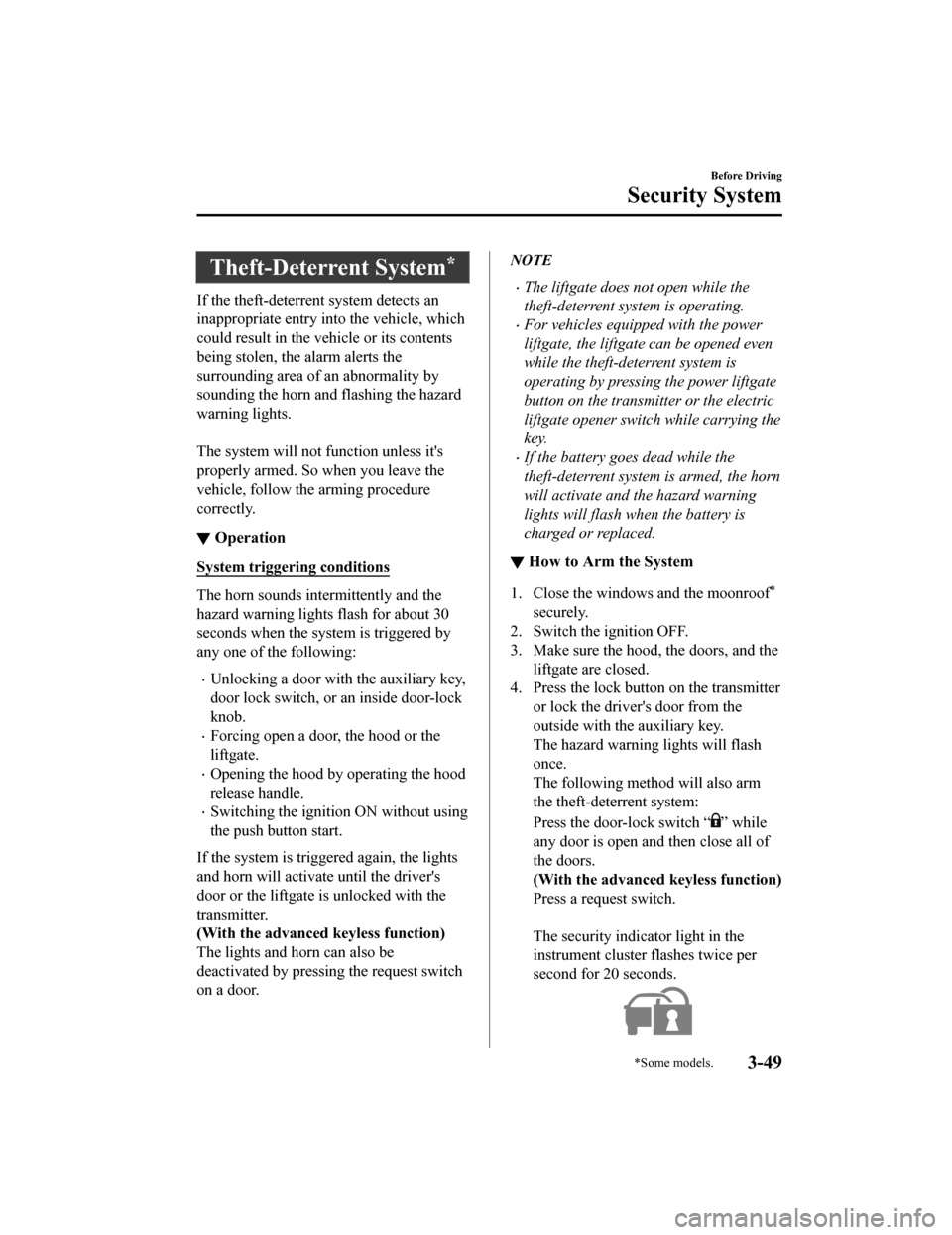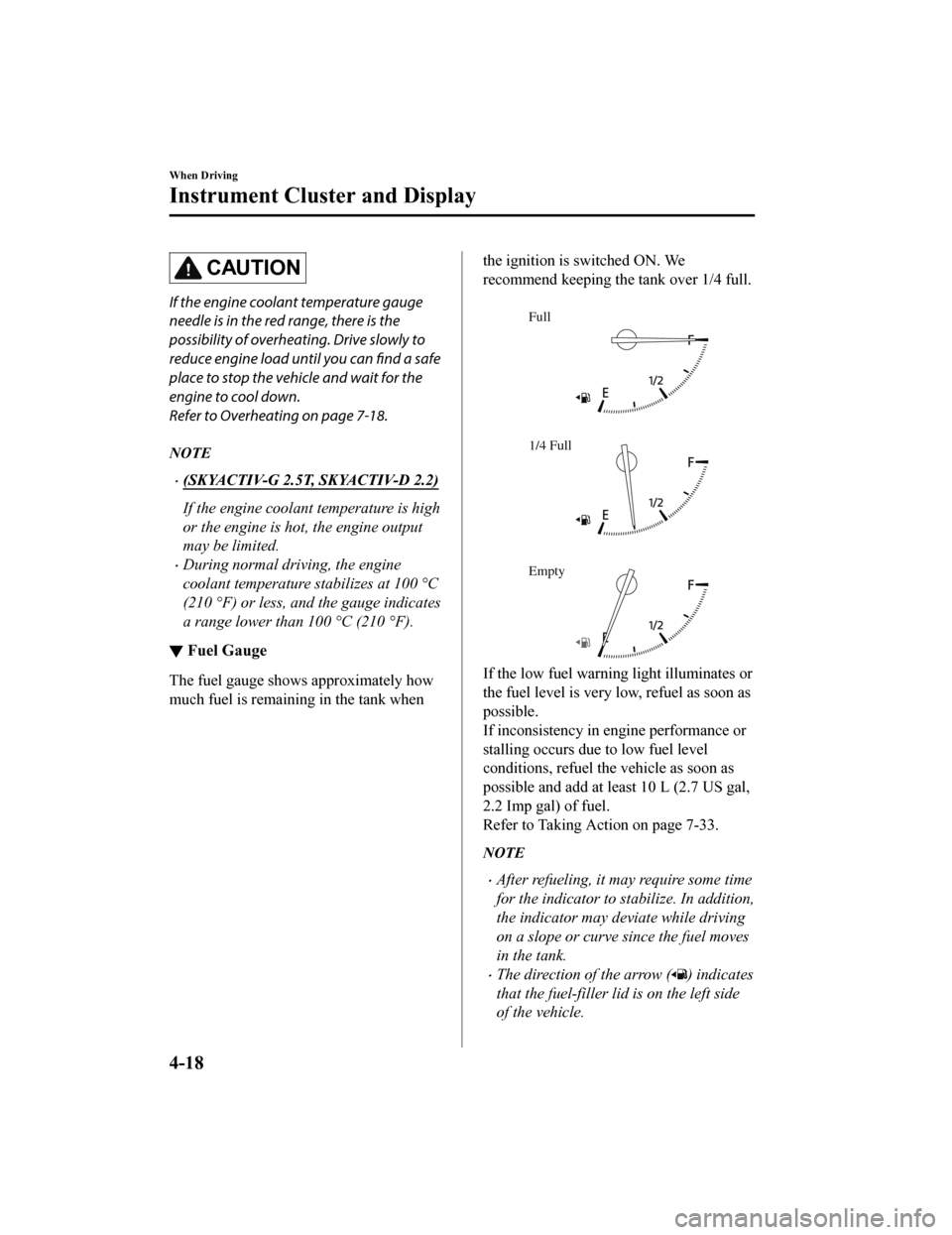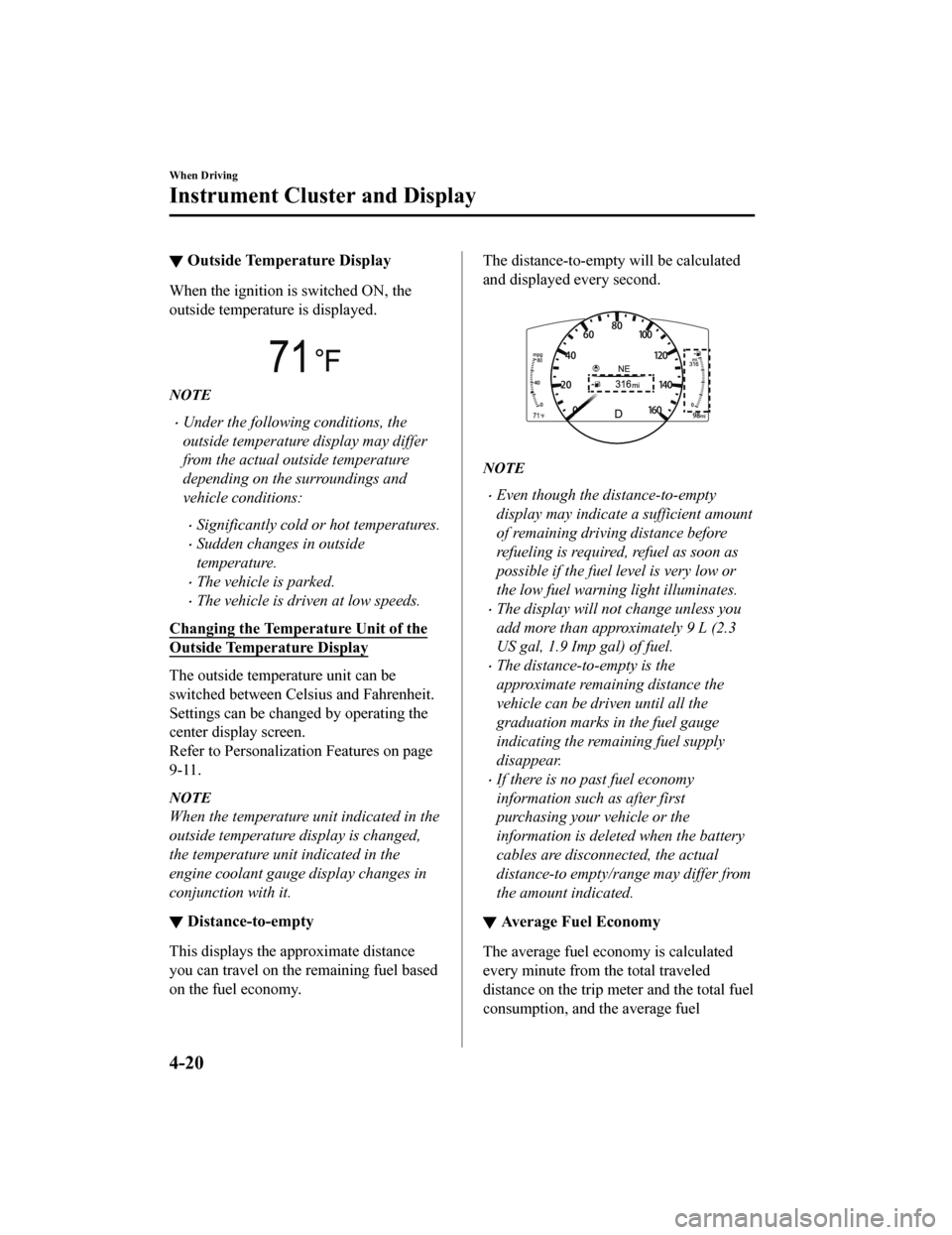warning light MAZDA MODEL CX-5 2020 (in English) Owner's Manual
[x] Cancel search | Manufacturer: MAZDA, Model Year: 2020, Model line: MODEL CX-5, Model: MAZDA MODEL CX-5 2020Pages: 714
Page 131 of 714

Power Windows
The windows can be opened/closed by operating the power window switches.
WA R N I N G
Make sure the opening is clear before closing a window:
Closing a power window is dangerous. A person's hands, head, or even neck could be caught
by the window and result in serious injury or even death. This warning applies especially to
children.
Never allow children to play with power window switches:
Power window switches that are not locked wi th the power window lock switch would allow
children to operate power windows unintentionally , which could result in serious injury if a
child's hands, head or neck becomes caught by the window.
Make sure nothing blocks the window just before it reaches the fully closed position or while
fully holding up the power window switch:
Blocking the power window just before it reach es the fully closed position or while fully
holding up the power window switch is dangerous.
In this case, the jam-safe function cannot prevent the window from closing all the way. If
fingers are caught, serious injuries could occur.
NOTE
When driving with only 1 of the rear windows open, your ears might experience a
resonating sound. However, this does not indicate a problem. The sound can be reduced by
slightly opening a front window or by changi ng the size of the rear window opening.
â–ĽOpening/Closing Windows
The window opens while the switch is pressed and it closes while the switch is pulled up
with the ignition switched ON. Do not open or close 3 or more windows at the same time.
Before Driving
Windows
3-41
CX-5_8HX6-EA-19I_Edition2_old
2019-9-19 9:26:07
Page 139 of 714

Theft-Deterrent System*
If the theft-deterrent system detects an
inappropriate entry into the vehicle, which
could result in the vehicle or its contents
being stolen, the alarm alerts the
surrounding area of an abnormality by
sounding the horn and flashing the hazard
warning lights.
The system will not function unless it's
properly armed. So when you leave the
vehicle, follow the arming procedure
correctly.
â–ĽOperation
System triggering conditions
The horn sounds intermittently and the
hazard warning lights flash for about 30
seconds when the system is triggered by
any one of the following:
ď‚·Unlocking a door with the auxiliary key,
door lock switch, or an inside door-lock
knob.
ď‚·Forcing open a door, the hood or the
liftgate.
ď‚·Opening the hood by operating the hood
release handle.
ď‚·Switching the ignition ON without using
the push button start.
If the system is triggered again, the lights
and horn will activate until the driver's
door or the liftgate is unlocked with the
transmitter.
(With the advanced keyless function)
The lights and horn can also be
deactivated by pressing the request switch
on a door.
NOTE
ď‚·The liftgate does not open while the
theft-deterrent system is operating.
ď‚·For vehicles equipped with the power
liftgate, the liftgate can be opened even
while the theft-deterrent system is
operating by pressing the power liftgate
button on the transmitter or the electric
liftgate opener switch while carrying the
key.
ď‚·If the battery goes dead while the
theft-deterrent system is armed, the horn
will activate and the hazard warning
lights will flash when the battery is
charged or replaced.
â–Ľ How to Arm the System
1. Close the windows and the moonroof*
securely.
2. Switch the ignition OFF.
3. Make sure the hood, the doors, and the
liftgate are closed.
4. Press the lock butt on on the transmitter
or lock the driver's door from the
outside with the auxiliary key.
The hazard warning lights will flash
once.
The following method will also arm
the theft-deterrent system:
Press the door-lock switch “
” while
any door is open and then close all of
the doors.
(With the advanced keyless function)
Press a request switch.
The security indicator light in the
instrument cluster flashes twice per
second for 20 seconds.
Before Driving
Security System
*Some models.3-49
CX-5_8HX6-EA-19I_Edition2_old 2019-9-19 9:26:07
Page 140 of 714

5. After 20 seconds, the system is fullyarmed.
NOTE
ď‚·The theft-deterrent system can also be
armed by activating the auto relock
function with all the doors, the liftgate
and the hood closed.
Refer to Transmitter on page 3-5.
ď‚·The system will disarm if one of the
following operations takes place within
20 seconds after pressing the lock
button:
ď‚·Unlocking any door.
ď‚·Opening any door.
ď‚·Opening the hood.
ď‚·Switching the ignition ON.
To rearm the system, do the arming
procedure again.
ď‚·When the doors are locked by pressing
the lock button on the transmitter or
using the auxiliary key while the
theft-deterrent system is armed, the
hazard warning lights will flash once to
indicate that the system is armed.
â–Ľ To Tu r n O f f a n A r m e d S y s t e m
An armed system can be turned off using
any one of the following methods:
ď‚·Pressing the unlock button on the
transmitter.
ď‚·Starting the engine with the push button
start.
ď‚·(With the advanced keyless function)
ď‚·Pressing a request switch on the
doors.
The hazard warning lights will flash twice.
NOTE
When the doors are unlocked by pressing
the unlock button on the transmitter while
the theft-deterrent system is turned off, the
hazard warning lights will flash twice to
indicate that the system is turned off.
â–Ľ To Stop the Alarm
A triggered alarm can be turned off using
any one of the following methods:
ď‚·Pressing the unlock button on the
transmitter.
ď‚·Starting the engine with the push button
start.
ď‚·(With the advanced keyless function)
ď‚·Pressing a request switch on the
doors.
ď‚·Pressing the electric liftgate opener
while the key is being carried.
ď‚·Pressing the power liftgate button on
the transmitter.
The hazard warning lights will flash twice.
Before Driving
Security System
3-50
CX-5_8HX6-EA-19I_Edition2_old 2019-9-19 9:26:07
Page 159 of 714

4When Driving
Information concerning safe driving and stopping.
Start/Stop Engine.............................. 4-4 Ignition Switch........ ..................... 4-4
Starting the Engine....................... 4-5
Turning the Engine Off............... 4-11
Instrument Cluster and Display ............
........................................................... 4-12 Instrument Cluster and
Display........................................4-12
Instrument Cluster (Type A)....... 4-13
Instrument Cluster (Type B)....... 4-30
Instrument Cluster (Type C)....... 4-46
Active Driving Display
*............. 4-58
Manual Transaxle Operation......... 4-61 Manual Transaxle Shift
Pattern......................................... 4-61
Automatic Transaxle....................... 4-64 Automatic Transaxle
Controls...................................... 4-64
Shift-Lock System...................... 4-65
Transaxle Ranges........................4-65
Manual Shift Mode..................... 4-67
Direct Mode
*.............................. 4-73
Driving Tips................................4-73
Switches and Controls..................... 4-75
Lighting Control......................... 4-75
Fog Lights
*................................. 4-81
Turn and Lane-Change
Signals........................................ 4-81
Windshield Wipers and
Washer........................................ 4-82
Rear Window Wiper and
Washer........................................ 4-86
Rear Window Defogg er.............. 4-86
Horn............................................ 4-88
Hazard Warning Flasher............. 4-89
HomeLink Wireless Control System
(Type A)
*.................................... 4-89
HomeLink Wireless Control System
(Type B)
*.................................... 4-93
Brake................................................ 4-97 Brake System.............................. 4-97
AUTOHOLD............................ 4-101
Hill Launch Assist (HLA)........ 4-105
ABS/TCS/DSC/Off-Road Traction
Assist............................................... 4-107 Antilock Brake System
(ABS)........................................4-107
Traction Control System
(TCS)........................................ 4-108
Dynamic Stability Control
(DSC)........................................ 4-110
Off-Road Traction Assist
*........ 4-111
Fuel Economy Monitor................. 4-113 Fuel Economy Monitor
*........... 4-113
*Some models.4-1
CX-5_8HX6-EA-19I_Edition2_old 2019-9-19 9:26:07
Page 160 of 714

Drive Selection............................... 4-116Drive Selection
*........................4-116
i-ACTIV AWD............................... 4-118 i-ACTIV AWD Operation
*....... 4-118
Power Steering...............................4-120 Power Steering......................... 4-120
i-ACTIVSENSE............................. 4-121
i-ACTIVSENSE
*......................4-121
Adaptive Front Lighting System
(AFS)
*...................................... 4-124
High Beam Control System
(HBC)
*......................................4-125
Blind Spot Monitoring (BSM)
*.........
.................................................. 4-128
Traffic Sign Recognition System
(TSR)
*...................................... 4-133
Distance Recognition Support
System (DRSS)
*....................... 4-139
Rear Cross Traffic Alert (RCTA)
*.....
.................................................. 4-143
Mazda Radar Cruise Control with
Stop & Go function (MRCC with
Stop & Go function)
*............... 4-147
Lane-keep Assist System (LAS) &
Lane Departure Warning System
(LDWS)
*.................................. 4-162
Advanced Smart City Brake Support
(Advanced SCBS)
*...................4-172
Smart City Brake Support
(SCBS)
*.................................... 4-175
Smart Brake Support (SBS)
*.... 4-178
360° View Monitor
*................. 4-181
Forward Sensing Camera (FSC)
*......
.................................................. 4-207
Radar Sensor (Front)
*.............. 4-212
Radar Sensors (Rear)
*.............. 4-215
Front Camera/Side Cameras/Rear
Camera
*.................................... 4-217
Cruise Control............................... 4-218 Cruise Control
*.........................4-218
4-2*Some models.
CX-5_8HX6-EA-19I_Edition2_old 2019-9-19 9:26:07
Page 163 of 714

(amber) illuminates when the ignition is
switched ON and the engine is not
running.)
Some indicator lights/warning lights
should be inspected before the engine is
started (page 4-12).
NOTE
(SKYACTIV-G 2.0, SKYACTIV-G 2.5,
SKYACTIV-G 2.5T)
When the push button start is pressed to
ON, the sound of the fuel pump motor
operating near the fuel tank can be heard.
This does not indicate an abnormality.
Starting the Engine
WA R N I N G
Radio waves from the key may
affect
medical devices such as pacemakers:
Before using the key near people who use
medical devices, ask the medical device
manufacturer or your physician if radio
waves from the key will affect the device.
NOTE
ď‚·The key must be carried because the key
carries an immobilizer chip that must
communicate with the engine controls at
short range.
ď‚·The engine can be started when the push
button start is pressed from off, ACC, or
ON.
ď‚·The push button start system functions
(function which can start the engine by
only carrying the key) can be
deactivated to prevent any possible
adverse effect on a user wearing a
pacemaker or other medical device. If
the system is deactivated, you will be
unable to start the engine by carrying
the key. Consult an Authorized Mazda
Dealer for details. If the push button
start system functions have been
deactivated, you can start the engine by
following the procedure indicated when
the key battery goes dead.
Refer to Engine Start Function When
Key Battery is Dead on page 4-8.
ď‚·After starting a cold engine, the engine
speed increases and a whining sound
from the engine compartment can be
heard.
When Driving
Start/Stop Engine
4-5
CX-5_8HX6-EA-19I_Edition2_old
2019-9-19 9:26:07
Page 165 of 714

CAUTION
If the KEY warning light (red)
illuminates, or the push button start
indicator light (amber) flashes, this
could indicate a problem with the
engine starting system. This may
prevent the engine from starting or
from switching the ignition to ACC or
ON (for vehicles with a type A/type B
instrument cluster (page 7-23),
messages are displayed in the
instrument cluster). Have your vehicle
inspected at an Authorized Mazda
Dealer as soon as possible.
NOTE
ď‚·Under the following conditions, the
KEY warning light (red) flashes after
the push button start is pressed. This
informs the driver that the push
button start will not switch to ACC,
even if it is pressed from off (for
vehicles with a type A/type B
instrument cluster (page 7-23),
messages are displayed in the
instrument cluster).
ď‚·The key battery is dead.
ď‚·The key is out of operational
range.
ď‚·The key is placed in areas where it
is difficult for the system to detect
the signal (page 3-8).
ď‚·A key from another manufacturer
similar to the key is in the
operational range.
ď‚·(Forced engine starting method)
If the KEY warning light (red)
illuminates, or the push button start
indicator light (amber) flashes, this
could indicate that the engine may
not start using the usual starting
method (for vehicles with a type A/
type B instrument cluster (page
7-23), messages are displayed in
the instrument cluster). Have your
vehicle inspected at an Authorized
Mazda Dealer as soon as possible. If
this occurs, the engine can be
force-started. Press and hold the
push button start until the engine
starts. Other procedures necessary
for starting the engine, such as
having the key in the cabin, and
depressing the clutch pedal (manual
transaxle) or the brake pedal
(automatic transaxle) are required.
ď‚·When the engine is force-started, the
KEY warning light (red) (if
equipped)remains illuminated and
the push button start indicator light
(amber) remains flashing.
ď‚·(Automatic transaxle)
When the selector lever is in the
neutral (N) position, the KEY
indicator light (green) (if
equipped)and the push button start
indicator light (green) do not
illuminate.
7. Press the push button start after both the KEY indicator light (green) (if
equipped)in the instrument cluster and
the push button start indicator light
(green) illuminate.
When Driving
Start/Stop Engine
4-7
CX-5_8HX6-EA-19I_Edition2_old 2019-9-19 9:26:07
Page 168 of 714

6. Press the push button start to start theengine.
NOTE
ď‚·The engine cannot be started unless
the clutch pedal is fully depressed
(manual transaxle) or the brake
pedal is fully depressed (automatic
transaxle).
ď‚·If there is a malfunction with the
push button start function, the push
button start indica tor light (amber)
flashes. In this ca se, the engine may
start, however, have the vehicle
checked at an Authorized Mazda
Dealer as soon as possible.
ď‚·If the push button start indicator
light (green) does not illuminate,
perform the operation from the
beginning again. If it does not
illuminate, have the vehicle checked
at an Authorized Mazda Dealer.
ď‚·To switch the ignition position
without starting the engine, perform
the following operations after the
push button start indicator light
(green) turns on.
1. Release the clutch pedal (manual transaxle) or brake pedal
(automatic transaxle).
2. Press the push button start to switch the ignition position. The
ignition switches in the order of
ACC, ON, and off each time the
push button start is pressed. To
switch the ignition position
again, perform the operation
from the beginning.
â–ĽEmergency Operation for Starting
the Engine
If the KEY warning light (red) illuminates,
or the push button start indicator light
(amber) flashes, this could indicate that
the engine may not start using the usual
starting method (for vehicles with a type
A/type B instrument cluster (page 7-23),
messages are displayed in the instrument
cluster). Have your vehicle inspected at an
Authorized Mazda Dealer as soon as
possible. If this occu
rs, the engine can be
force-started. Press and hold the push
button start until the engine starts. Other
procedures necessary for starting the
engine such as having the key in the cabin,
and depressing the clutch pedal (manual
transaxle) or the brake pedal (automatic
transaxle) are required.
When Driving
Start/Stop Engine
4-10
CX-5_8HX6-EA-19I_Edition2_old 2019-9-19 9:26:07
Page 176 of 714

CAUTION
If the engine coolant temperature gauge
needle is in the red range, there is the
possibility of overheating. Drive slowly to
reduce engine load until you can find a safe
place to stop the vehicle and wait for the
engine to cool down.
Refer to Overheating on page 7-18.
NOTE
ď‚·(SKYACTIV-G 2.5T, SKYACTIV-D 2.2)
If the engine coolant temperature is high
or the engine is hot, the engine output
may be limited.
ď‚·During normal driving, the engine
coolant temperature stabilizes at 100 °C
(210 °F) or less, and the gauge indicates
a range lower than 100 °C (210 °F).
â–ĽFuel Gauge
The fuel gauge shows approximately how
much fuel is remaining in the tank when
the ignition is switched ON. We
recommend keeping the tank over 1/4 full.
Full
1/4 Full
Empty
If the low fuel warning light illuminates or
the fuel level is very
low, refuel as soon as
possible.
If inconsistency in engine performance or
stalling occurs due to low fuel level
conditions, refuel the vehicle as soon as
possible and add at least 10 L (2.7 US gal,
2.2 Imp gal) of fuel.
Refer to Taking Action on page 7-33.
NOTE
ď‚·After refueling, it may require some time
for the indicator to st abilize. In addition,
the indicator may deviate while driving
on a slope or curve since the fuel moves
in the tank.
ď‚·The direction of the arrow () indicates
that the fuel-filler lid is on the left side
of the vehicle.
When Driving
Instrument Cluster and Display
4-18
CX-5_8HX6-EA-19I_Edition2_old 2019-9-19 9:26:07
Page 178 of 714

â–ĽOutside Temperature Display
When the ignition is
switched ON, the
outside temperature is displayed.
NOTE
ď‚·Under the following conditions, the
outside temperature display may differ
from the actual outside temperature
depending on the surroundings and
vehicle conditions:
ď‚·Significantly cold or hot temperatures.
ď‚·Sudden changes in outside
temperature.
ď‚·The vehicle is parked.
ď‚·The vehicle is driven at low speeds.
Changing the Temperature Unit of the
Outside Temperature Display
The outside temperature unit can be
switched between Cels ius and Fahrenheit.
Settings can be changed by operating the
center display screen.
Refer to Personalization Features on page
9-11.
NOTE
When the temperature unit indicated in the
outside temperature display is changed,
the temperature unit indicated in the
engine coolant gauge display changes in
conjunction with it.
â–Ľ Distance-to-empty
This displays the approximate distance
you can travel on the remaining fuel based
on the fuel economy.
The distance-to-empty will be calculated
and displayed every second.
NOTE
ď‚·Even though the distance-to-empty
display may indicate a sufficient amount
of remaining driving distance before
refueling is required, refuel as soon as
possible if the fuel level is very low or
the low fuel warning light illuminates.
ď‚·The display will not change unless you
add more than approximately 9 L (2.3
US gal, 1.9 Imp gal) of fuel.
ď‚·The distance-to-empty is the
approximate remaining distance the
vehicle can be driven until all the
graduation marks in the fuel gauge
indicating the remaining fuel supply
disappear.
ď‚·If there is no past fuel economy
information such as after first
purchasing your vehicle or the
information is deleted when the battery
cables are disconnected, the actual
distance-to empty/range may differ from
the amount indicated.
â–Ľ Average Fuel Economy
The average fuel economy is calculated
every minute from the total traveled
distance on the trip meter and the total fuel
consumption, and the average fuel
When Driving
Instrument Cluster and Display
4-20
CX-5_8HX6-EA-19I_Edition2_old
2019-9-19 9:26:07